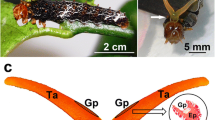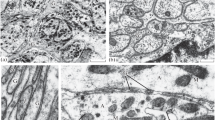Summary
From crude extracts ofHydra tissue a substance has been purified which prevents or retards the asexual reproduction by budding. The molecular weight is in the range of 300 to 1000 daltons. Inhibition of bud formation can be observed with concentrations equivalent to the extract from one hydra per 4 ml, that is, to a more than 10,000-fold dilution of the initial crude extract of a hydra. The purified inhibitor is active at a concentration of less than 10−8 M.
Most of the inhibitor present inHydra is bound to cells. Within the cells the substance is mainly bound to particulate structures which sediment at 10,000 g. Its concentration is highest in the hypostomal region and decreases in the direction of the tentacles and peduncle. A second, lower, peak has been found in the basal disc. Treatment of the animals with a toxic agent (nitrogen mustard) which depletes the animal of interstitial cells, nematocytes and nematoblasts excludes the possibility that the inhibitor is present to any great extent in these cells. In conjunction with cell separation experiments by centrifugation of fixed cells in suspension, these results indicate that nerve cells are the most likely sites of storage of the inhibiting substance, although epithelial cells are not excluded as sources for the inhibitor.
Similar content being viewed by others
References
Beloussov, L.B., Geleg, S.: Chemical regulation of the morphogenesis of hydroid polyps. Dokl. Akad. Nauk. S.S.S.R.,130, 1165–1168 (1960)
Bode, H., Berking, S., David, C.N., Gierer, A., Schaller, H., Trenkner, E.: Quantitative analysis of cell types during growth and morphogenesis inhydra. Wilhelm Roux' Archiv EntwMech. Org.171, 269–285 (1972)
Burnett, A.L.: A model of growth and cell differentiation inhydra. Amer. Naturalist.100, 165–189 (1966)
Child, C.M.: Patterns and problems of development. Chicago: Univ. of Chicago Press (1941)
David, C.N.: Quantitative method for maceration ofhydra tissue. Wilhelm Roux' Archiv EntwMech. Org.171, 259–268 (1972)
Davis, L.V.: The source and identity of a regeneration-inhibiting factor in hydroid polyps. J. Exp. Zool.164, 187–194 (1967)
Diehl, F., Burnett, A.L.: The role of interstitial cells in maintenance ofhydra. I. Specific destruction of interstitial cells in normal, asexual, non-budding animals. J. Exp. Zool.155, 253–260 (1964)
Gierer, A., Berking, S., Bode, H., David, C.N., Flick, K., Hansmann, G., Schaller, H., Trenkner, E.: Regeneration ofhydra from reaggregated cells. Nature New Biol.239, 98–101 (1972)
Gierer, A., Meinhardt, H.: A theory of biological pattern formation. Kybernetik12, 30–39 (1972)
Goodwin, B.C., Cohen, H.M.: A phase-shift model for the spatial and temporal organization of developing systems. J. theor. Biol.25, 49–107 (1969)
Kannev, J.J.:Hydra. Essays on the biology of fresh water polyps. Originally published by Soviet. Academy of Sciences, Moscow (ed. H.M. Lenhoff) 1952
Lenhoff, H.M., Loomis, W.F.: The control of clonal growth ofhydra by self-inhibition of tentacle differentiation. Anat. Rec.127, 429–430 (1957)
Lenicque, P., Lundblad, D.: Promoters and Inhibitors of Development during Regeneration of the Hypostome and Tentacles ofHydra littoralis.Acta Zool. 47, 277–287 (1966)
Lentz, T.L.: The cell biology of Hydra, Amsterdam: North-Holland 1966
Lesh, G.E., Burnett, A.L.: Some biological and biochemical properties of the polarizing factor inHydra. Nature, London204, 492–493 (1964)
Lesh, G.E., Burnett, A.O.L.: An analysis of the chemical control of the polarized form inhydra. J. Exp. Zool.163, 55–78 (1966)
MacWilliams, H.K., Kafatos, F.C., Bossert, W.H.: The feedback inhibition of basal disk regeneration inhydra has a continuously variable intensity. Develop. Biol.23, 380–398 (1970)
Müller, W.A., Spindler, K.: The “polarizing inducer” inHydra: a reexamination of its properties and its origin. Wilhelm Roux' Archiv EntwMech. Org.167, 325–335 (1971)
Powers, J.A.: Effects of distal and proximal hydranth extracts and stem extracts from adultTubularia on the regeneration of isolated proximal ridge regions. Biol. Bull.121, 404 (1961)
Rose, S.M.: Polarized control of regional structure inTubularia. Develop. Biol.7, 488–501 (1963)
Rose, S.M., Rose, F.C.: The role of a cut surface inTubularia regeneration. Phys. Zool.14, 328–343 (1941)
Schaller, H.: Isolation and characterization of a low-molecular-weight substance activating head and bud formation inhydra. J. Embryol. Exp. Morph.29, 27–38 (1973)
Schaller, H., Gierer, A.: Distribution of the head-activating substance inhydra and its localisation in membranous particles in nerve cells. J. Embryol. exp. Morph.29, 39–52 (1973)
Tardent, P.: Zum Nachweis eines regenerationshemmenden Stoffes im Hydranth vonTubularia. Rev. Suisse Zool.62, 289–294 (1955)
Tardent, P., Eymann, H.: Some chemical and physical properties of the regeneration-inhibitor ofTubularia. Acta Embryol. Morphol. Exp.1, 280–287 (1958)
Turing, A.: The chemical basis of morphogenesis. Phil. Trans. Roy. Soc. B237, 32 (1952)
Trenkner, E., Flick, K., Hansmann, G., Bode, H., Bode, P.: Studies onhydra cellsin vitro. J. Exp. Zool.185, 317–326 (1973)
Tweedell, K.S.: A bacteria-free inhibitor of regeneration inTubularia. Biol. Bull.115, 369 (1958)
Tweedell, K.S.: Inhibition of regeneration inTubularia by tissue extract injection. Biol. Bull.123, 513 (1962)
Webster, G.: Morphogenesis and pattern formation in hydroids. Biol. Rev.46, 1–46 (1971)
Wolpert, L.: Positional information and the spatial pattern of cellular differentiation. J. theor. Biol.25, 1–47 (1969)
Author information
Authors and Affiliations
Rights and permissions
About this article
Cite this article
Berking, S. Bud formation inHydra: Inhibition by an endogenous morphogen. Wilhelm Roux' Archiv 181, 215–225 (1977). https://doi.org/10.1007/BF00848422
Received:
Accepted:
Issue Date:
DOI: https://doi.org/10.1007/BF00848422




